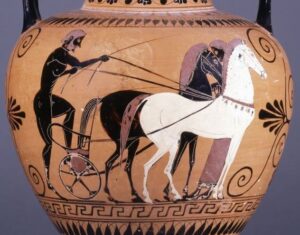
Have you ever been in a meeting, about to make a presentation, and your heart starts to thump? You tell yourself: Calm down. Take a deep breath. You hear your mother’s voice telling you you’re too emotional. But the trapped bird in your chest just won’t chill.
Or, do you pride yourself on making decisions based on “just the facts”? Do you refer to yourself as a logician, a stoic? Have you been chided for being too much in your head, not enough in your heart?
Western culture sometimes divides us into being either “feelers” or “thinkers,” binary labels for dichotomous personality types. At least since the Greeks, we’ve prized rationality over emotion, relegating the latter to the bottom rung of our psychic life. We’ve been conditioned to consider hunger, sexual desire, and the emotions the baser instinctual drives, inferior to willpower and intellect, the markers of “high civilization.”
 In The Dragons of Eden (1977), Carl Sagan laid out a three-part model of the human brain that reinforced this hierarchy of functions. In this model, our brains evolved in layers. The oldest and deepest layer is the reptilian brain, the seat of our basic survival instincts. The second or middle layer is the limbic system, sometimes called “the emotional brain.” The outermost layer, the most sophisticated and most recent part of the brain, is the neocortex, thought to be responsible for rational thought. Emotions were located in the lower two strata and deemed counterproductive, even damaging.
In The Dragons of Eden (1977), Carl Sagan laid out a three-part model of the human brain that reinforced this hierarchy of functions. In this model, our brains evolved in layers. The oldest and deepest layer is the reptilian brain, the seat of our basic survival instincts. The second or middle layer is the limbic system, sometimes called “the emotional brain.” The outermost layer, the most sophisticated and most recent part of the brain, is the neocortex, thought to be responsible for rational thought. Emotions were located in the lower two strata and deemed counterproductive, even damaging.
Until recently, there were few challenges to this model of the human brain. But new imaging techniques and advances in neuroscience have overthrown the old understanding of brain anatomy — and even introduced a new field of study designed specifically to address the role of emotions: affective neuroscience.
In his new book Emotional: How Feelings Shape Our Thinking (2022), author and theoretical physicist Leonard Mlodinow makes a solid case for a more nuanced understanding of brain interconnectivity and the role emotions play in our lives. A marvelous storyteller, he illustrates through anecdote and current research the myth of objectivity: we do not make decisions, the best decisions, solely with our logical minds. On the contrary, emotions are always part of our decision-making process, whether we are aware of them or not.
 Emotions, Mlodinow explains, are intricately networked within our brains. He points to studies in affective neuroscience that indicate that the way our brain processes information cannot be divorced from emotion. He writes: “While rational thought allows us to draw logical conclusions based on our goals and relevant data, emotion operates at a more abstract level—it affects the importance we assign to the goals and the weight we give to the data. It forms a framework for our assessments that is not only constructive but necessary.”
Emotions, Mlodinow explains, are intricately networked within our brains. He points to studies in affective neuroscience that indicate that the way our brain processes information cannot be divorced from emotion. He writes: “While rational thought allows us to draw logical conclusions based on our goals and relevant data, emotion operates at a more abstract level—it affects the importance we assign to the goals and the weight we give to the data. It forms a framework for our assessments that is not only constructive but necessary.”
Simply put, emotion helps us judge and place value on the facts.
An overwhelming negative emotion can alter our view of reality. But logic alone is limited. Sometimes what you are trying to cope with has more nuances than a systematic or rational approach can apprehend.
In his Teaching Company course “Questions of Value,” philosopher Patrick Grim distinguishes between facts and value. “One could have a complete factual picture of the universe yet not know the first thing about value,” he writes. “One could know all the facts about the history and methods of execution and still not know whether the death penalty is justified.”
Our feelings not only connect us to others and to the natural world, but they help us determine what is important to us and why.
Most of us are aware of how we habitually respond to certain situations: Do we go with our “gut feelings” or do we analyze the pros and cons? As a novelist, I dive deep into my characters’ personalities so that I can write them from the inside out. I have to ask myself, is this a person who will act calm and collected, but throw up the minute they walk out of the room? Trying to understand the emotions of the characters I create leads me to deeper self-knowledge and the desire to do more research into our fascinating human world.
Consider this: on January 20, 1942, Reinhard Heydrich, SS chief Heinrich Himmler’s deputy, presided over a meeting of fifteen high-ranking Nazis, eight of them scientists. One of the participants was Heydrich’s advisor on Jewish policy, Adolf Eichmann. The reason for the meeting, later called the Wannsee Conference, was to discuss the Fuhrer’s plans for the extermination of the Jewish population of Europe, the Final Solution.
For several hours, with utmost precision and logic, the men at the conference discussed methods of transporting massive Jewish populations to crematoria as well as methods of mass extermination. The scientists and technocrats at the Wannsee Conference were embroiled in a discussion of facts—the facts of the evacuation of Jewish populations, the facts of how many people might be transported, and how could they calculate the cost, in Reichsmarks, of human slaughter. If there was an emotional outburst or response from any of the participants, it was not recorded. These were men with a job to do, the job of genocide, and they reported for duty with measured thoughtfulness and interest.
 History offers us this chilling example of logical thinking divorced from emotion and its consequences. The current humanitarian tragedy inflicted by a despotic ruler upon the population of Ukraine offers another horrific example.
History offers us this chilling example of logical thinking divorced from emotion and its consequences. The current humanitarian tragedy inflicted by a despotic ruler upon the population of Ukraine offers another horrific example.
These are the grimmest pictures of logic split off from feeling. We shudder and think ourselves incapable of such dissociation, but what should we expect when we continue to encourage boys not to cry or girls not to show anger? What today’s neuroscience is showing us is that we make better decisions when we acknowledge and integrate our emotions into our thinking. We don’t have to choose. Emotions ignored become troubling emotions. Logic by itself is incomplete. Being sensitive to and expressing how we respond to circumstances emotionally are key to self-awareness and a few giant steps toward a balanced life.
This post appeared in a slightly different form on Dale’s blog on Psychology Today. You can find all of Dale’s blog posts for Psychology Today at